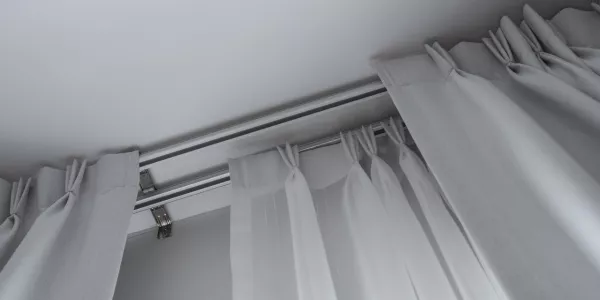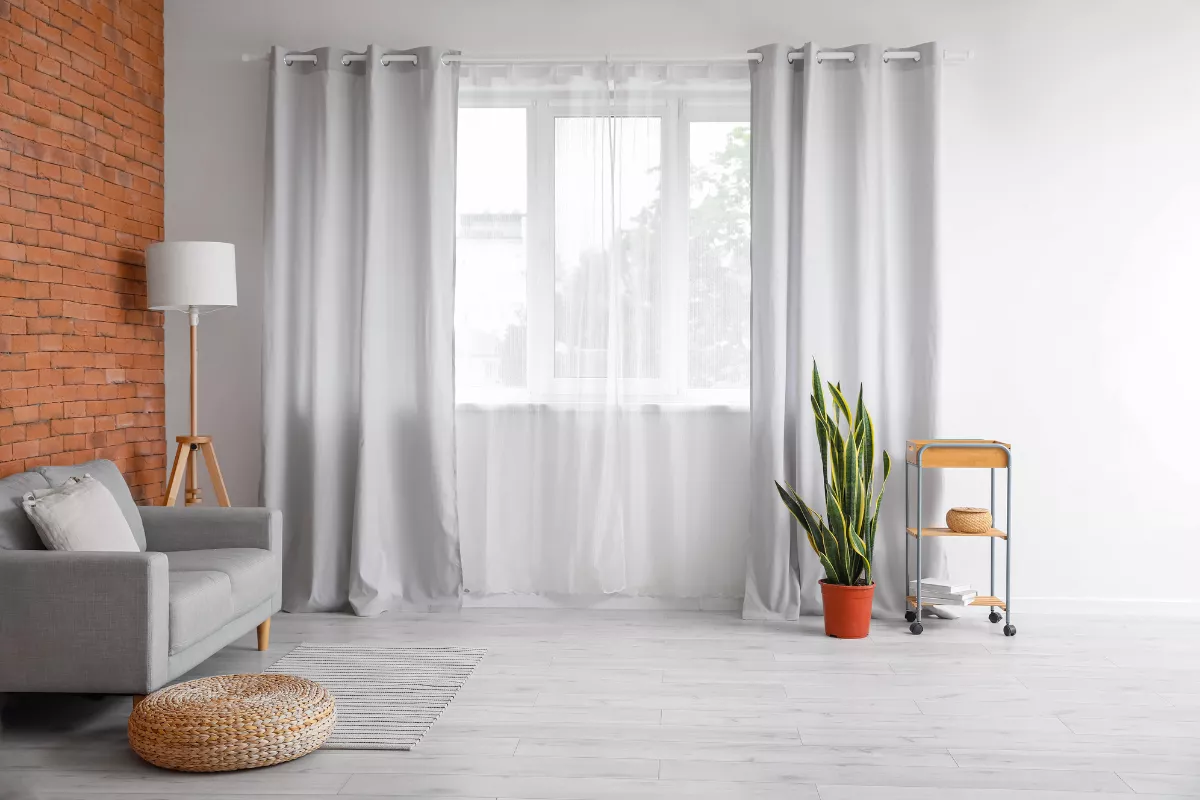Numerous methods exist for hanging curtains and drapes, each impacting your room's appearance and, possibly, the installation approach. For instance, positioning curtains higher and wider than the window dimensions can create an illusion of a more spacious room and larger windows.
Situations like mounting curtains on windows with pre-existing blinds or opting for non-drilling methods in apartments are also considerations.
Additionally, the length at which the curtains or drapes extend below the window is important. Opting for floor-length drapes lends a formal ambiance to the space, whereas curtains that reach just to the sill may be better suited for areas like kitchens or bedrooms.
A challenging aspect of installing curtains is deciding the correct placement for the rod. This decision varies based on several elements, such as the window's style, the kind of window treatment, and the room's ceiling height. Keep all these aspects in mind when planning and setting up your curtains or drapes.
Choose between drill or non-drilling method
If the place where you are going to hang the curtain already has blinds with the correct measurements you need, your job is half way done. But if it is not, you will need to install the rod brackets yourself.
If you decide to drill, you will need some tools and materials like:
- Curtain Rods: Choose a rod that suits the style and weight of your curtains.
- Curtain Brackets: These will hold the rod in place. Ensure they are compatible with your curtain rod.
- Drill: A power drill for making holes in the wall.
- Drill Bits: Ensure you have the right size for your wall type (drywall, plaster, wood, or concrete).
- Screws and Wall Anchors: These are used to secure the brackets to the wall. Wall anchors are essential if you're drilling into drywall for added support.
- Screwdriver: In case you need to manually tighten the screws.

For those who prefer not to drill holes in their walls or are restricted by lease agreements, there are several non-drilling methods to hang curtains, like:
Tension Rods:
These rods are adjustable and stay in place by tension. They are perfect for lightweight curtains and fit inside the window frame without any need for screws or hardware.
Command Hooks:
These adhesive-backed hooks are a great option for hanging lightweight curtains. Make sure to choose hooks that can support the weight of your curtains and follow the installation instructions for the best hold.
Magnetic Curtain Rods:
Ideal for steel window frames, magnetic rods attach directly to the window frame without any hardware. They are easy to install and remove, making them perfect for temporary setups.
Measuring
After choosing your curtain and hang method, it’s time for a critical step: To measure!
Despite the method, you want to make sure you are placing the brackets on the right spot. To measure you will need measuring tape, a level, and a pencil.
Width Measurement
With a pencil and measuring tape, indicate where you want your curtain brackets to go, positioning the rod approximately 4 to 6 inches above the window frame.
Before proceeding with curtain installation, ensure that the curtain panels are sufficiently wide enough to span your home's windows. It's essential to prevent unwanted sunlight from sneaking through uncovered spaces.
Ideally, the combined width of your curtain panels should be around double the width of the window. Remember, measuring your windows before buying the curtains can save you from unexpected surprises.
Length Measurement
Install the curtain brackets roughly 6 inches away from the outer edge of the window frame to ensure ample natural light enters the room.
Selecting the appropriate length for your curtains is equally crucial. Curtains that are too short not only look out of place but also create an illusion of lower ceilings and a smaller room. Conversely, curtains that are excessively long can be a safety hazard due to tripping and tend to gather dust. The best choice is curtains that slightly “kiss” the floor.
Tips
- Measure the thickness of the window trim to establish the perfect size for the curtain brackets. Choose brackets that protrude beyond the trim's depth. If the brackets are not deep enough, your curtains will not drape correctly.
- To determine the correct length of your curtains, measure from the floor to the planned rod height, which is typically about 4 to 6 inches above the window frame. Alternatively, mounting the curtain rod just beneath the ceiling can cleverly give the impression of higher ceilings.
Selecting an Appropriate Curtain Rod Width

Furthermore, it's important to opt for a curtain rod that extends beyond the width of your window. This enables the curtains to be fully drawn to the window's sides, creating a sense of a more spacious area. Ideally, the curtain rod should exceed the width of the window by 8 to 12 inches, providing an additional 4 to 6 inches on each side.
Choosing the Right Size and Style of Your Curtains
Considerations for your style include:
- The level of formality in your personal style. Long curtains look more formal.
- The overall look and feel of your room. Short curtains can make the room look smaller and out of place.
- Your preference for either sheer curtains that allow more light or those that block light, including blackout options.
- The decision to opt for longer curtains to add depth to the room.
- Remember, if you're opting for custom-made curtains, account for the time required to place the order and receive them, which can span several weeks.
Hanging the rod brackets
If you opt for non-drilling, now that everything is measured well, you just need to attach the detachable anchors directly to the walls. However, if you chose to drill, follow this steps:
- For heavier curtains, it's essential to drill pilot holes or use wall anchors for additional support.
- Fasten the brackets firmly to wall studs (a stud finder tool is handy here) or utilize toggle bolts for a secure attachment of rods to the wall, especially in areas lacking studs.
- Make sure to install the brackets evenly from one side to the other and at the correct height above the floor for a balanced look.
- Thread the rod through the pocket at the top of the curtain, through the eyelets, or for certain styles, you might need to attach the drapery hooks to the pleats at the curtain's top.
Hang the Curtains
Time to hang the curtains. Raise them into position while they are connected to the rod or hanging hooks. This process often necessitates the help of another person and likely the use of one or two step ladders.
People also ask
Should curtains touch the floor?
Floor-length curtains are usually the most popular option. Beyond the contemporary and fashionable appearance, there are practical advantages too, such as enhanced insulation and effective light blocking around the window to prevent drafts.
How do I choose the right curtain color and fabric?
When choosing the color of your curtains, consider if you prefer them to seamlessly integrate with your room's decor or stand out as a centerpiece in the living room. For a subtler effect, opt for curtains that match the color of the walls or the trim in the room.
What are blackout curtains, and when should I use them?
Blackout curtains are window coverings made of fabric that obstruct sunlight and light from external sources like passing vehicles and streetlights. They offer an additional barrier over blinds, which often have small openings that permit light infiltration.
Blackouts are excellent for bedrooms to enhance sleep quality, particularly for those with irregular sleep schedules, by blocking out sunlight. They are also ideal for media rooms to reduce screen glare, and their insulating properties help in energy efficiency, keeping rooms warm in winter and cool in summer, which can lower energy bills. Furthermore, it is worth mentioning the privacy they offer.

 Marcio Vasconcelos
Marcio Vasconcelos





